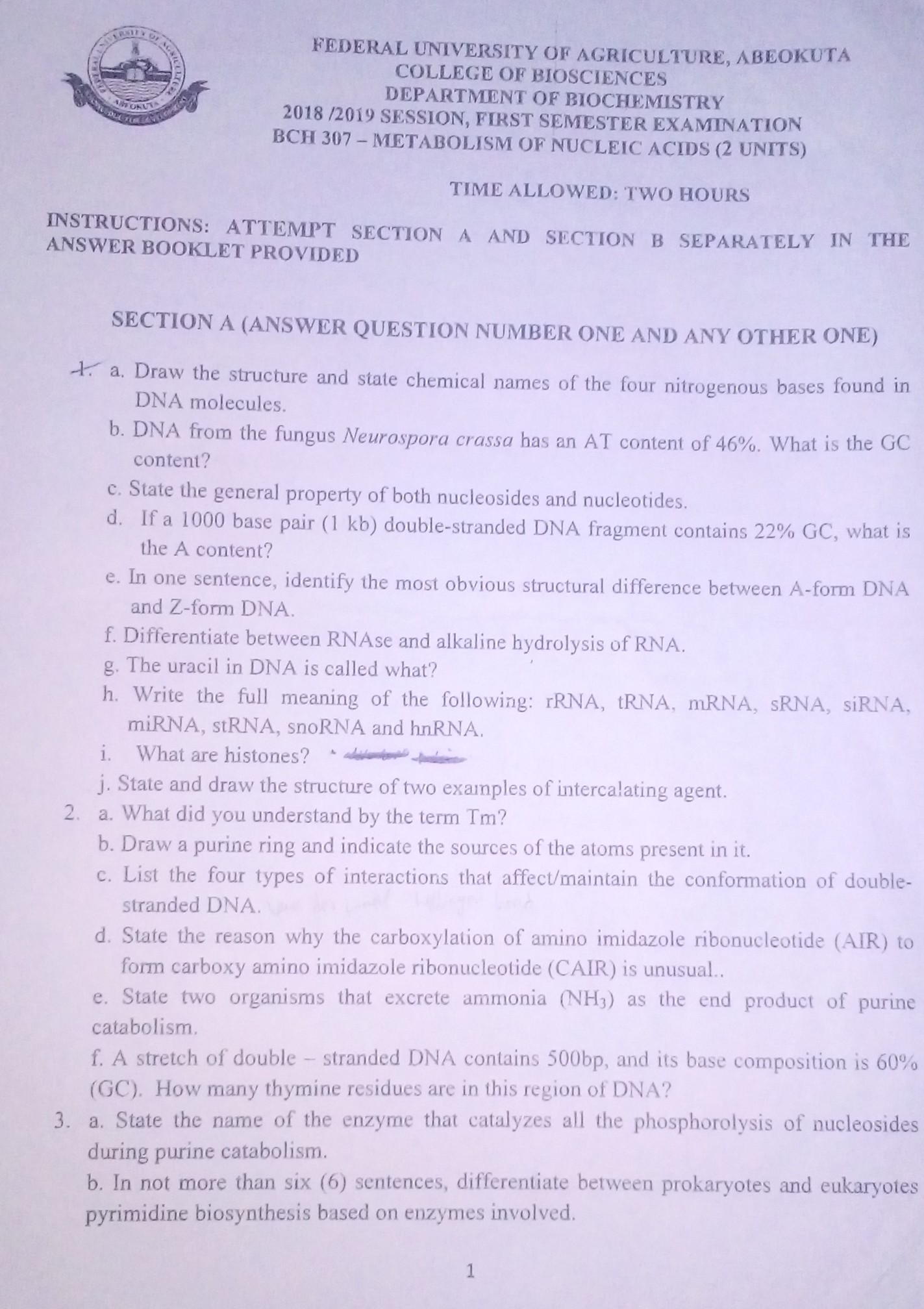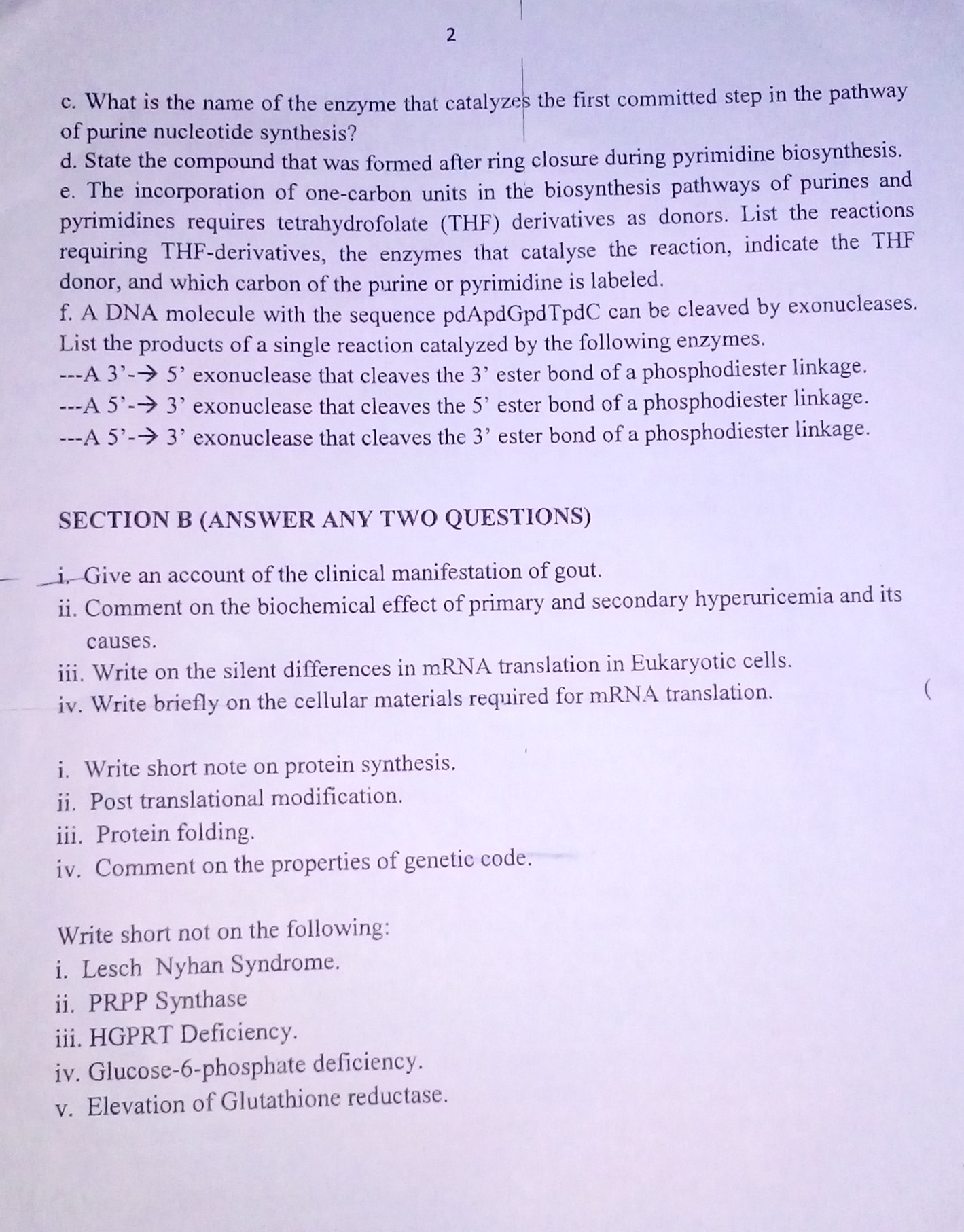

SECTION A
Question 1
(a) Draw the structure and state chemical names of the four nitrogenous bases found in DNA molecules.
(b) DNA from the fungus Neurospora crassa has an AT content of 46%. What is the GC content
(c) state the general property of both nucleoside and nucleotides.
(d) If a 1000 base pair (1kb) double- tranced DNA fragment contains 22% GC, what is the A content?
(e) In one sentence, identify the most obvious structural difference between A-form DNA and Z-form DNA
(f) Differenciate between RNAse and alkaline hydrolysis of RNA.
(g) The uracile in DNA is called What?
(h) Write the full meaning of the following: rRNA, tRNA, mRNA, sRNA, siRNA, miRNA, stRNA, snoRNA and hnRNA
(i) What are histones?
(j) State and draw the structure of two examples of intercalating agent.
Question 2
(a) what did you understand by the term Tm?
(b) Draw a purine ring and indicate the sources of the atoms present in it.
(c) List the four types of interactions that affect/maintain the conformation of double-stranded DNA.
(d) State the reason why the the carboxylation of amino imidazole ribonucleotide (AIR) to form carboxy Amino imidazole ribonucleotide (CAIR) is unusual
(e) State two organisms that excrete ammonia (NH3) as the end product of purine catabolism.
(f) A stretch of double - stranded DNA contains 500bp, and it's base composition is 60% (GC). How many thymine residues are in this region of DNA?
Question 3
(a) State the name of the enzyme that catalyzes all the phosphorolysis of nucleosides during purine catabolism.
(b) In not more than six (6) sentences, differentiate between prokaryotes and eukaryotes pyrimidine biosynthesis bases on enzymes involved.
(c) What is the name of the enzyme that catalyzes the first committed step in the pathway of purine nucleotide synthesis?.
(d) state the compound that was formed after ring closure during pyrimidine biosynthesis.
(e) The incorporation of one carbon units in the biosynthesis pathways of purines and pyrimidines requires tetrahydrofolate (THF) derivatives as donors. List the reactions requiring THF- derivatives, the enzymes that catalyse the reaction, indicate the THF donor, and which carbon of the purine or pyrimidine is labeled.
(f) A DNA molecules with the sequence pdApdGpdTpdC can be cleared by exonucleases. List the products of a single reaction catalyzed by the following enzymes,
--A 3' - -⟩ 5' exonucleases that cleaves the 3' ester bond of a phosphodiester linkage
--A 5' - -⟩ 3' exonucleases that cleaves the 5' ester bond of a phosphodiester linkage
--A 5' - -⟩ 3' exonucleases that cleaves the 3' ester bond of a phosphodiester linkage
SECTION B
(I) Give an account of the clinical manifestation of gout.
(II) Comment on the biochemical effect of primary and secondary hyperuricemia and it's causes.
(III) Write on the silent differences in mRNA translation in Eukaryotic cells.
(IV) write briefly on the cellular materials required for mRNA translation.
Question 2
(I) Write short note on protein synthesis.
(II) Post translational modification.
(III) protein folding.
(IV) Comment on the properties of genetic code.
Question 3
Write short note on the following
(I) Lesch Nyhan Syndrome.
(II) PRPP synthase.
(III) HGPRT deficiency.
(IV) Glucose-6-phosphate deficiency.
(V) Elevation of Glutathione reductase
.....
